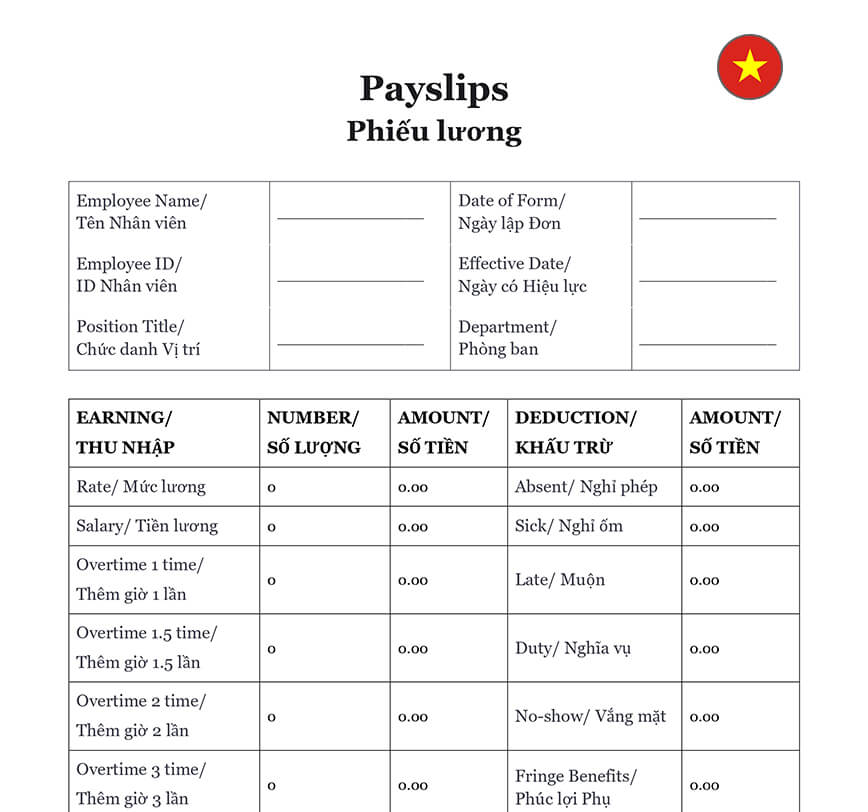Ready to use legal template
Work on without any hassle
Vietnamese-English translation
Ready to use legal template
Work on without any hassle
Vietnamese-English translation
Home › Accounting › Payslip
Learn more about Payslip in Vietnam
A payslip is a formal document provided by an employer to an employee, detailing the breakdown of their salary for a specific pay period. It typically includes information such as gross earnings, deductions (e.g., taxes, insurance, social contributions), and net pay. In Vietnam, issuing payslips is not only a best practice for transparency but also aligns with labor law obligations under the Labor Code. Payslips serve as an important record for both employers and employees, helping to resolve disputes, maintain accurate payroll records, and ensure compliance with statutory requirements. Download our Payslip Form available in an easy to edit Word format and drafted by expert in English and Vietnamese.
Table of contents
What is a Payslip?
What is included in a Payslip?
Why is a Payslip important in Vietnam?
What is the Payroll Process in Vietnam?
Are employers legally required to provide employees with Payslip Forms?
How can employers issue Payslip Forms in Vietnam?
What are the Payroll deductions?
Why outsource Payroll Services?
What is a Payslip?
A Payslip, often referred to as a salary slip or payroll slip, is an essential document issued by employers to their employees detailing the financial aspects of their employment. It serves as a comprehensive record of the employee’s earnings and deductions for a specific pay period, typically on a monthly or bi-weekly basis. Within a Payslip, crucial information such as the employee’s gross earnings before deductions, taxes withheld, various deductions including for insurance or retirement contributions, and ultimately the net pay or take-home salary is provided. This document not only serves as proof of payment for the employee but also ensures transparency and accountability in the employment relationship, outlining the breakdown of how an employee’s salary is calculated and dispersed.
Beyond its role in documenting financial transactions, a Payslip plays a vital role in maintaining legal compliance and fostering trust between employers and employees. It helps both parties understand their financial obligations and rights, providing clarity on matters such as tax withholdings and deductions. Furthermore, Payslips serve as valuable records for employees, facilitating the monitoring of their earnings over time and aiding in financial planning. By accurately reflecting the compensation structure in line with legal regulations and organizational policies, Payslips contribute to the overall integrity and fairness of the employment arrangement, fostering a positive and transparent work environment.
What is included in a Payslip?
A Payslip typically includes several key pieces of information essential for both employers and employees:
Employee Information: This section includes details such as the employee’s name, employee ID or number, and sometimes their position or department within the company.
Earnings: Payslips detail the employee’s gross earnings for the pay period, which typically encompass regular salary or wages, overtime pay, bonuses, commissions, or any other forms of compensation.
Deductions: This part of the Payslip outlines various deductions taken from the employee’s earnings. Common deductions include taxes (such as income tax, social security contributions, and Medicare deductions), pension or retirement contributions, health insurance premiums, and any other voluntary deductions agreed upon by the employee.
Taxes Withheld: Payslips often include a breakdown of the taxes withheld from the employee’s earnings, including federal, state, and local income taxes, as well as any other applicable taxes.
Net Pay: The net pay, also known as the take-home pay, is the amount remaining after all deductions have been subtracted from the gross earnings. This is the amount the employee actually receives in their paycheck.
Employer Information: Payslips typically include the name and contact information of the employer or the company issuing the Payslip.
Pay Period: This indicates the specific dates covered by the Payslip, such as the start and end dates of the pay period.
Year-to-Date (YTD) Totals: Some Payslips include year-to-date totals for earnings, taxes withheld, and deductions, providing employees with a summary of their earnings and deductions since the beginning of the calendar year.
These elements collectively provide a transparent breakdown of an employee’s earnings and deductions for a specific pay period, ensuring clarity and accountability in the employment relationship.
Why is a Payslip important in Vietnam?
A Payslip holds significant importance in Vietnam for several reasons:
| ➤ Legal Compliance: In Vietnam, employers are required by law to provide Payslips to their employees. The Labor Code of Vietnam mandates that employees must receive a Payslip with detailed information about their salary, deductions, and taxes for each pay period. Compliance with these regulations ensures that employers adhere to labor laws and regulations, promoting transparency and fairness in employment practices. |
| ➤ Employee Rights: Payslips serve as an essential tool for protecting the rights of employees in Vietnam. By providing detailed information about their earnings, deductions, and taxes, Payslips empower employees to verify that they are being paid accurately and fairly for their work. This transparency helps prevent wage disputes and ensures that employees receive the compensation they are entitled to under their employment contracts and relevant labor laws. |
| ➤ Tax Compliance: In Vietnam, taxes are typically withheld from employees' salaries by employers and remitted to the appropriate tax authorities. Payslips provide employees with a clear breakdown of the taxes withheld from their earnings, helping them understand their tax obligations and ensuring compliance with tax laws. Additionally, Payslips enable employees to track their taxable income and deductions, which is essential for filing accurate tax returns. |
| ➤ Financial Planning: Payslips provide employees with valuable information for financial planning and budgeting. By clearly outlining their earnings, deductions, and net pay, Payslips help employees understand their financial situation and make informed decisions about saving, spending, and managing their finances. This financial transparency contributes to employees' overall financial well-being and stability. |




